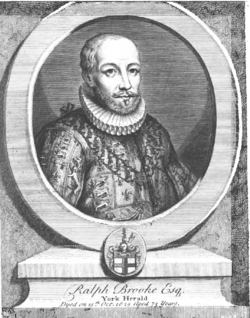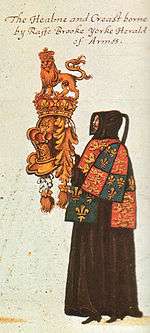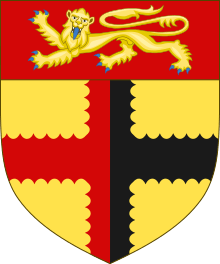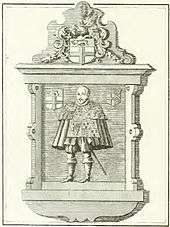Ralph Brooke
Ralph Brooke (1553–1625)[1] was an English Officer of Arms in the reigns of Elizabeth I and James I. He is known for his critiques of the work of other members of the College of Arms, most particularly in A Discoverie of Certaine Errours Published in Print in the Much Commended 'Britannia' 1594, which touched off a feud with its author, the revered antiquarian and herald William Camden.

Life and works
Brooke was educated at the Merchant Taylors' School. He was appointed Rouge Croix Pursuivant in 1580 and York Herald in 1593.[2] As York Herald, he bore the helm and crest in the funeral procession of Elizabeth I.[3]
In 1597, Brooke published A Discoverie of Certaine Errours Published in Print in the Much Commended 'Britannia' 1594, which occasioned a bitter controversy with Britannia's author, the antiquarian William Camden.[4]

Brooke also challenged the work of other heralds; in 1602 he prepared charges against Sir William Dethick, Garter King of Arms 1586–1606, and Camden for improperly granting arms to 23 "mean" men, including John Shakespeare of Stratford-upon-Avon, the father of playwright William Shakespeare.[5] He complained in 1614 that Robert Cooke, Clarenceux King of Arms 1566–1593, had granted more than 500 new coats of arms and that Sir Gilbert Dethick, (Garter 1550–1584), and his son Sir William had exceeded these numbers.[4] Such bitter infighting among the heralds was common; Sir William Segar (Garter 1606–1633) also objected that Cooke made numberless grants to "base and unworthy persons for his private gaine onely."[4][6]
In December 1616 Brooke tricked Segar into confirming foreign royal arms to Gregory Brandon, a common hangman of London who was masquerading as a gentleman.[7] Brooke then reported Segar to James I, who imprisoned both Brooke and Segar in Marshalsea.[7] They were released a few days later and the Lord Chamberlain hoped that the experience would make Brooke more honest and Segar more wise.[7]
Brooke's Catalogue and Succession of the Kings, Princes, Dukes, Marquesses, Earles and Viscounts of this Realme of England since the Norman Conquest was published in 1619.[2] A revised edition of the Discoverie "...to which is added, the learned Mr. Camden's answer to this book, and Mr. Brooke's reply" was issued in 1622, as was an expanded edition of the Catalogue and Succession..., as Catalogue and Succession of the Kings, Princes, Dukes, Marquesses, Earles and Viscounts of this Realme of England since the Norman Conquest, to this present year 1622.[8]
Brooke died on 16 October 1625 and was buried inside St Mary's Church, Reculver, where he was commemorated by a black marble tablet on the south wall of the chancel, showing him dressed in his herald's coat.[9]
Arms
 |
|
Notes

- Dictionary of National Biography 2004, "Ralph Brooke"
- Dictionary of National Biography 1903, p. 150
- Annotated drawing of the funeral procession of Elizabeth I, from the British Library
- Rockett 2000
- Evans 1997, p. 1954
- Wagner 1967, p. 207
- Wagner 1967, p. 219-220
- Open Library list of works by Ralph Brooke
- Duncombe 1784, pp. 73, 89, Plate 2
References
- Duncombe, J. (1784). "The history and antiquities of the two parishes of Reculver and Herne, in the county of Kent". In Nichols, J. (ed.). Bibliotheca Topographica Britannica. 18. Nichols. pp. 65–161. OCLC 475730544.
- Evans, G. Blakemore, ed. (1997). The Riverside Shakespeare. 2. Houghton Mifflin Harcourt. ISBN 978-0-395-85822-6. Retrieved 24 August 2009.
- Lee, Sir Sidney, editor (1903). Dictionary of National Biography: index and epitome. Smith, Elder. Retrieved 23 August 2009.
- Oxford University Press (2004). "Oxford Dictionary of National Biography, "Ralph Brooke"". Retrieved 23 August 2009.
- Rockett, William (22 June 2000). "Britannia, Ralph Brooke, and the Representation of Privilege in Elizabethan England". Renaissance Quarterly. 53 (2): 474–499. doi:10.2307/2901876. JSTOR 2901876. Retrieved 23 August 2009.
- Wagner, Anthony (1967). Heralds of England: A History of the Office and College of Arms. Her Majesty's Stationery Office, London.
External links
- Brooke, Ralph (1724). A Discoverie of Certaine Errours Published in Print in the Much Commended 'Britannia' 1594. printed for James Woodman and David Lyon.
| Heraldic offices | ||
|---|---|---|
| Preceded by Thomas Dawes |
Rouge Croix Pursuivant of Arms 1580–1592 |
Succeeded by Thomas Knight |
| Preceded by Humphry Hales |
York Herald of Arms 1593–1625 |
Succeeded by William Le Neve |